最新八大时态的标志词
- 格式:ppt
- 大小:294.50 KB
- 文档页数:17
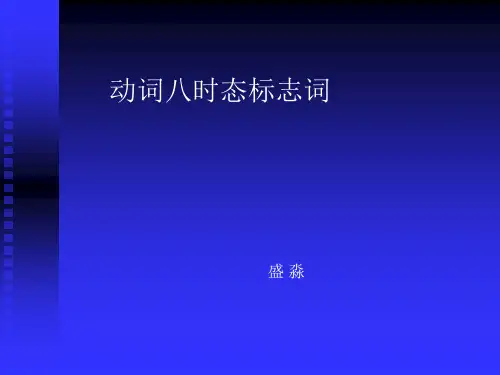
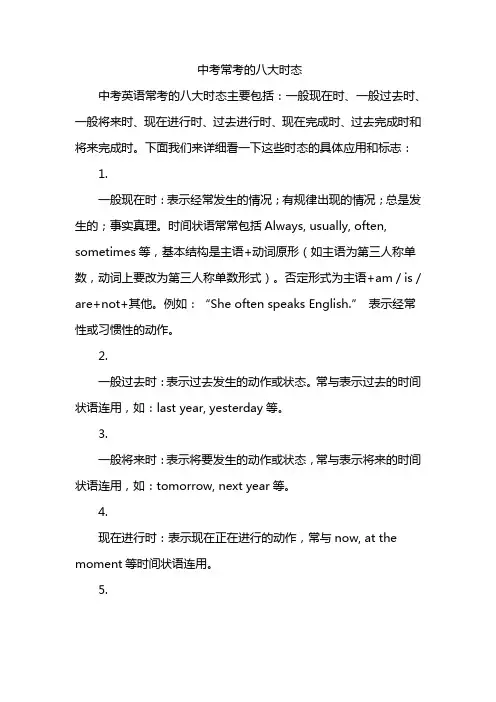
中考常考的八大时态中考英语常考的八大时态主要包括:一般现在时、一般过去时、一般将来时、现在进行时、过去进行时、现在完成时、过去完成时和将来完成时。
下面我们来详细看一下这些时态的具体应用和标志:1.一般现在时:表示经常发生的情况;有规律出现的情况;总是发生的;事实真理。
时间状语常常包括Always, usually, often, sometimes等,基本结构是主语+动词原形(如主语为第三人称单数,动词上要改为第三人称单数形式)。
否定形式为主语+am / is / are+not+其他。
例如:“She often speaks English.”表示经常性或习惯性的动作。
2.一般过去时:表示过去发生的动作或状态。
常与表示过去的时间状语连用,如:last year, yesterday等。
3.一般将来时:表示将要发生的动作或状态,常与表示将来的时间状语连用,如:tomorrow, next year等。
4.现在进行时:表示现在正在进行的动作,常与now, at the moment等时间状语连用。
5.过去进行时:表示过去某一时刻正在进行的动作,常与at this time yesterday, at that moment等时间状语连用。
6.现在完成时:表示过去发生的动作对现在造成的影响或结果,常与already, yet, just等副词连用。
7.过去完成时:表示在过去某一时间之前已经发生的动作,常与before, by the time等引导的短语或从句连用。
8.将来完成时:表示在将来某一时间之前将要完成的动作,常与by the time等引导的短语或从句连用。
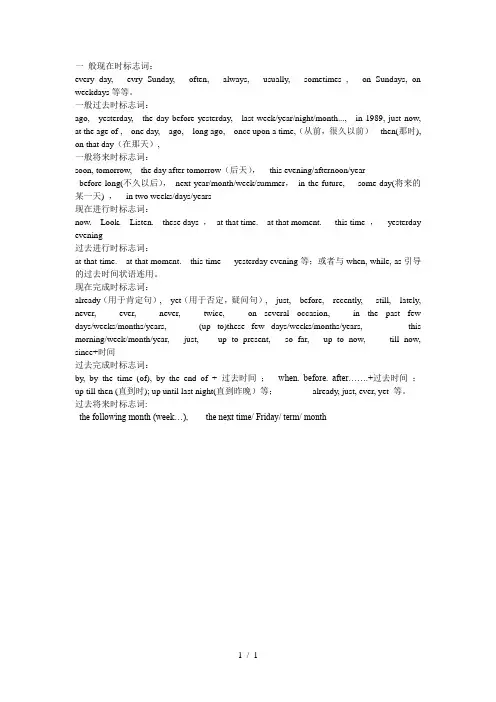
一般现在时标志词:every day, evry Sunday, often, always, usually, sometimes , on Sundays, on weekdays等等。
一般过去时标志词:ago, yesterday, the day before yesterday, last week/year/night/month..., in 1989, just now, at the age of , one day, ago, long ago, once upon a time,(从前,很久以前)then(那时), on that day(在那天),一般将来时标志词:soon, tomorrow, the day after tomorrow(后天),this evening/afternoon/yearbefore long(不久以后),next year/month/week/summer,in the future, some day(将来的某一天) ,in two weeks/days/years现在进行时标志词:now. Look. Listen. these days ,at that time. at that moment. this time ,yesterday evening过去进行时标志词:at that time. at that moment. this time yesterday evening等;或者与when, while, as引导的过去时间状语连用。
现在完成时标志词:already(用于肯定句), yet(用于否定,疑问句), just, before, recently, still, lately, never, ever, never, twice, on several occasion, in the past few days/weeks/months/years, (up to)these few days/weeks/months/years, this morning/week/month/year, just, up to present, so far, up to now, till now, since+时间过去完成时标志词:by, by the time (of), by the end of + 过去时间;when. before. after…….+过去时间;up till then (直到时); up until last night(直到昨晚)等;already, just, ever, yet 等。

一般现在时标志词:every day,evry Sunday,often,always,usually,sometimes ,on Sundays,on weekdays等等。
一般过去时标志词:ago,yesterday,the day before yesterday,last week/year/night/month (i)1989,just now,at the age of ,one day,ago,long ago,once upon a time,(从前,很久以前)then(那时),on that day(在那天),一般将来时标志词:soon,tomorrow,the day after tomorrow(后天),this evening/afternoon/yearbefore long(不久以后),next year/month/week/summer,in the future,some day(将来的某一天),in two weeks/days/years现在进行时标志词:now.Look.Listen.these days,at that time.at that moment.this time,yesterday evening过去进行时标志词:at that time.at that moment.this timeyesterday evening等;或者与when, while, as引导的过去时间状语连用。
现在完成时标志词:already(用于肯定句), yet(用于否定,疑问句), just, before, recently,still, lately,never, ever, never, twice, onseveraloccasion,in the past few days/weeks/months/years, (up to)thesefewdays/weeks/months/years, this morning/week/month/year, just,up to present, so far, up to now, till now, since+时间过去完成时标志词:by, by the time (of), by the end of +过去时间;when. before.after…….+过去时间;uptillthen(直到时);upuntillastnight(直到昨晚)等;already, just, ever, yet 等。
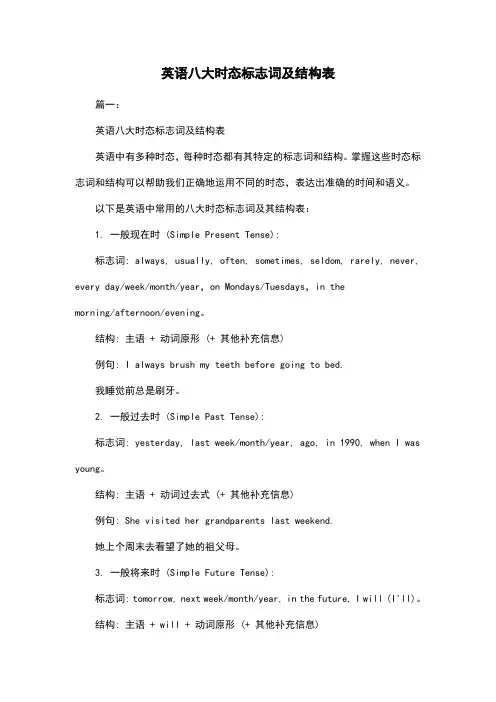
英语八大时态标志词及结构表篇一:英语八大时态标志词及结构表英语中有多种时态,每种时态都有其特定的标志词和结构。
掌握这些时态标志词和结构可以帮助我们正确地运用不同的时态,表达出准确的时间和语义。
以下是英语中常用的八大时态标志词及其结构表:1. 一般现在时 (Simple Present Tense):标志词: always, usually, often, sometimes, seldom, rarely, never, every day/week/month/year,on Mondays/Tuesdays,in themorning/afternoon/evening。
结构: 主语 + 动词原形 (+ 其他补充信息)例句: I always brush my teeth before going to bed.我睡觉前总是刷牙。
2. 一般过去时 (Simple Past Tense):标志词: yesterday, last week/month/year, ago, in 1990, when I was young。
结构: 主语 + 动词过去式 (+ 其他补充信息)例句: She visited her grandparents last weekend.她上个周末去看望了她的祖父母。
3. 一般将来时 (Simple Future Tense):标志词: tomorrow, next week/month/year, in the future, I will (I'll)。
结构: 主语 + will + 动词原形 (+ 其他补充信息)例句: We will go shopping tomorrow.我们明天去购物。
4. 现在进行时 (Present Continuous Tense):标志词: now, at the moment, currently, right now, look!。
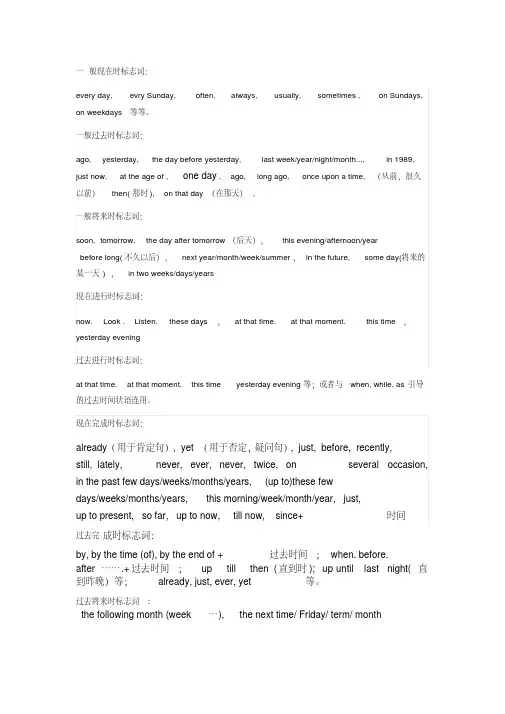
一般现在时标志词:every day, evry Sunday, often, always, usually, sometimes , on Sundays,on weekdays等等。
一般过去时标志词:ago, yesterday, the day before yesterday, last week/year/night/month..., in 1989,just now, at the age of , one day, ago, long ago, once upon a time,(从前,很久以前)then(那时), on that day(在那天),一般将来时标志词:soon, tomorrow, the day after tomorrow(后天),this evening/afternoon/yearbefore long(不久以后),next year/month/week/summer,in the future, some day(将来的某一天) ,in two weeks/days/years现在进行时标志词:now. Look. Listen. these days ,at that time. at that moment. this time ,yesterday evening过去进行时标志词:at that time. at that moment. this time yesterday evening等;或者与when, while, as引导的过去时间状语连用。
现在完成时标志词:already(用于肯定句), yet(用于否定,疑问句), just, before, recently,still, lately, never, ever, never, twice, on several occasion, in the past few days/weeks/months/years, (up to)these fewdays/weeks/months/years, this morning/week/month/year, just,up to present, so far, up to now, till now, since+时间过去完成时标志词:by, by the time (of), by the end of + 过去时间; when. before. after…….+过去时间; up till then (直到时); up until last night(直到昨晚)等; already, just, ever, yet 等。
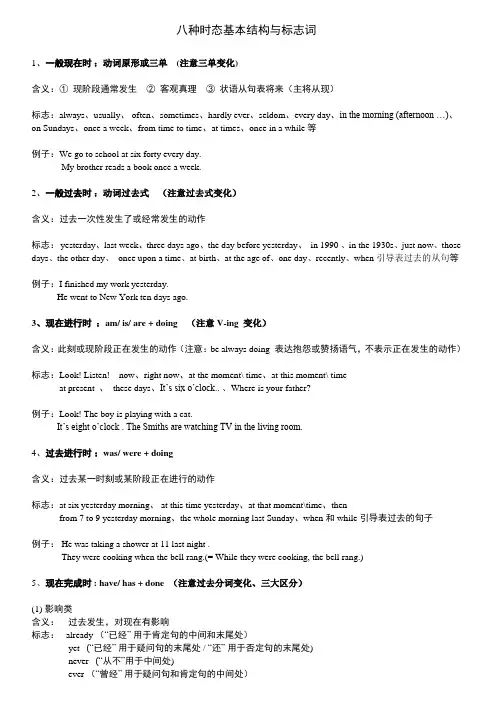
八种时态基本结构与标志词1、一般现在时:动词原形或三单(注意三单变化)含义:①现阶段通常发生②客观真理③状语从句表将来(主将从现)标志:always、usually、 often、sometimes、hardly ever、seldom、every day、in the morning (afternoon …)、on Sundays、once a week、from time to time、at times、once in a while等例子:We go to school at six forty every day.My brother reads a book once a week.2、一般过去时:动词过去式(注意过去式变化)含义:过去一次性发生了或经常发生的动作标志: yesterday、last week、three days ago、the day before yesterday、in 1990 、in the 1930s、just now、those days、the other day、once upon a time、at birth、at the age of、one day、recently、when引导表过去的从句等例子:I finished my work yesterday.He went to New York ten days ago.3、现在进行时:am/ is/ are + doing (注意V-ing 变化)含义:此刻或现阶段正在发生的动作(注意:be always doing 表达抱怨或赞扬语气,不表示正在发生的动作)标志:Look! Listen! now、right now、at the moment\ time、at this moment\ timeat present 、these days、It’s six o’clock..、Where is your father?例子:Look! The boy is playing with a cat.It’s eight o’clock . The Smiths are watching TV in the living room.4、过去进行时:was/ were + doing含义:过去某一时刻或某阶段正在进行的动作标志:at six yesterday morning、 at this time yesterday、at that moment\time、thenfrom 7 to 9 yesterday morning、the whole morning last Sunday、when和while引导表过去的句子例子: He was taking a shower at 11 last night .They were cooking when the bell rang.(= While they were cooking, the bell rang.)5、现在完成时 : have/ has + done (注意过去分词变化、三大区分)(1)影响类含义:过去发生,对现在有影响标志:already (“已经”用于肯定句的中间和末尾处)yet (“已经”用于疑问句的末尾处 / “还”用于否定句的末尾处)never (“从不”用于中间处)ever (“曾经”用于疑问句和肯定句的中间处)just (“刚刚”用于中间处)before ("之前" 用于句尾)once/ twice/ three times...例子:I have just cleaned my clothes. 我刚洗过衣服。
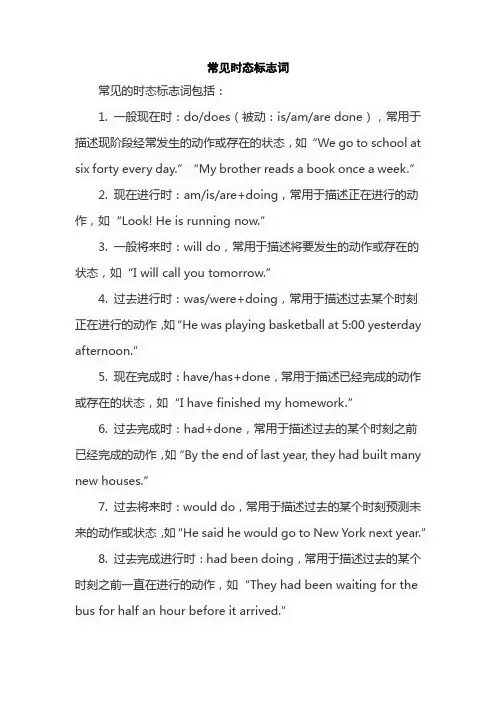
常见时态标志词常见的时态标志词包括:1. 一般现在时:do/does(被动:is/am/are done),常用于描述现阶段经常发生的动作或存在的状态,如“We go to school at six forty every day.”“My brother reads a book once a week.”2. 现在进行时:am/is/are+doing,常用于描述正在进行的动作,如“Look! He is running now.”3. 一般将来时:will do,常用于描述将要发生的动作或存在的状态,如“I will call you tomorrow.”4. 过去进行时:was/were+doing,常用于描述过去某个时刻正在进行的动作,如“He was playing basketball at 5:00 yesterday afternoon.”5. 现在完成时:have/has+done,常用于描述已经完成的动作或存在的状态,如“I have finished my homework.”6. 过去完成时:had+done,常用于描述过去的某个时刻之前已经完成的动作,如“By the end of last year, they had built many new houses.”7. 过去将来时:would do,常用于描述过去的某个时刻预测未来的动作或状态,如“He said he would go to New York next year.”8. 过去完成进行时:had been doing,常用于描述过去的某个时刻之前一直在进行的动作,如“They had been waiting for the bus for half an hour before it arrived.”这些时态标志词可以帮助我们更好地理解和使用英语中的时态,在不同的语境中表达准确的时间关系和动作状态。
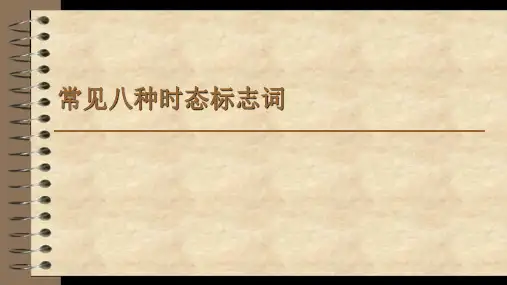
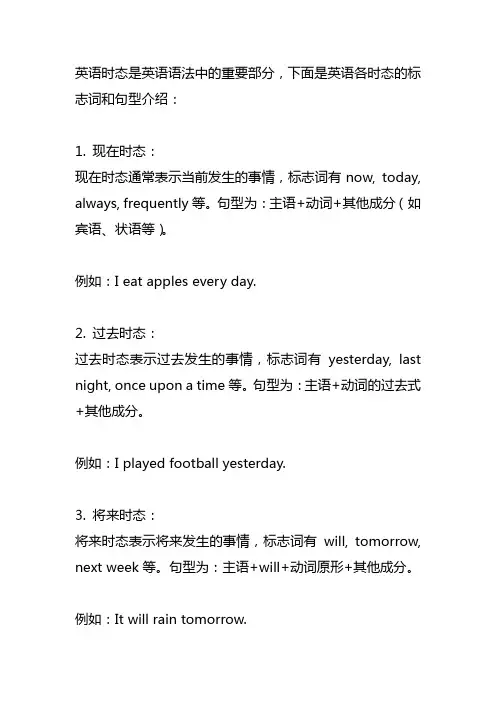
英语时态是英语语法中的重要部分,下面是英语各时态的标志词和句型介绍:1. 现在时态:现在时态通常表示当前发生的事情,标志词有now, today, always, frequently等。
句型为:主语+动词+其他成分(如宾语、状语等)。
例如:I eat apples every day.2. 过去时态:过去时态表示过去发生的事情,标志词有yesterday, last night, once upon a time等。
句型为:主语+动词的过去式+其他成分。
例如:I played football yesterday.3. 将来时态:将来时态表示将来发生的事情,标志词有will, tomorrow, next week等。
句型为:主语+will+动词原形+其他成分。
例如:It will rain tomorrow.4. 进行时态:进行时态表示正在进行的事情,标志词有be动词和动词ing 形式。
句型为:主语+be动词+动词ing形式+其他成分。
例如:She is singing a song now.5. 完成时态:完成时态表示已经完成的事情,标志词有have, had等。
句型为:主语+have/has+动词过去分词+其他成分。
例如:I have finished my homework.6. 完成进行时态:完成进行时态表示某个动作已经完成,并且这个动作是在过去一段时间内持续进行的。
标志词有have been, had been 等。
句型为:主语+have/has been+动词的现在分词+其他成分。
例如:I have been studying English for two years.7. 过去进行时态:过去进行时态表示在过去某个时间点正在进行的事情,标志词有was, were等。
句型为:主语+was/were+动词ing形式+其他成分。
例如:I was watching TV at 8:00 yesterday evening.8. 过去完成时态:过去完成时态表示在过去某个时间点之前已经完成的事情,标志词有had, had been等。
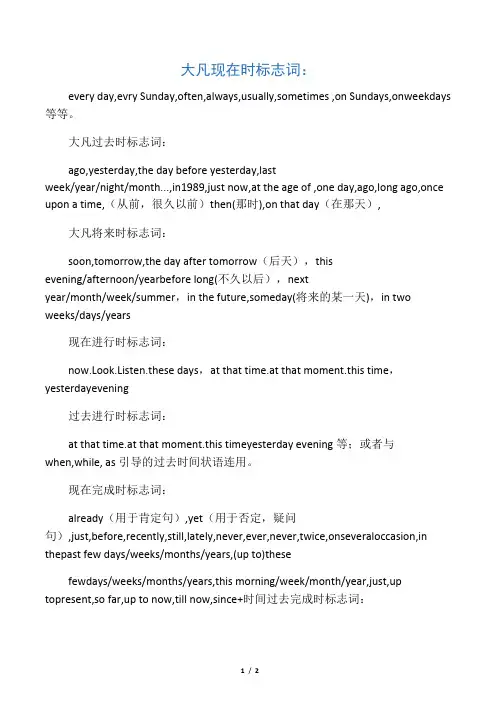
大凡现在时标志词:every day,evry Sunday,often,always,usually,sometimes ,on Sundays,onweekdays 等等。
大凡过去时标志词:ago,yesterday,the day before yesterday,lastweek/year/night/month...,in1989,just now,at the age of ,one day,ago,long ago,once upon a time,(从前,很久以前)then(那时),on that day(在那天),大凡将来时标志词:soon,tomorrow,the day after tomorrow(后天),thisevening/afternoon/yearbefore long(不久以后),nextyear/month/week/summer,in the future,someday(将来的某一天),in two weeks/days/years现在进行时标志词:now.Look.Listen.these days,at that time.at that moment.this time,yesterdayevening过去进行时标志词:at that time.at that moment.this timeyesterday evening等;或者与when,while, as引导的过去时间状语连用。
现在完成时标志词:already(用于肯定句),yet(用于否定,疑问句),just,before,recently,still,lately,never,ever,never,twice,onseveraloccasion,in thepast few days/weeks/months/years,(up to)thesefewdays/weeks/months/years,this morning/week/month/year,just,up topresent,so far,up to now,till now,since+时间过去完成时标志词:by, by the time (of), by the end of +过去时间;when. before.after…….+过去时间;uptillthen(直到时);upuntillastnight(直到昨晚)等;already, just, ever, yet 等。
英语八大时态标志词及结构表篇一:英语八大时态标志词及结构表正文:英语中存在八大时态,分别是:过去时、现在时、将来时、过去将来时、现在进行时、将来进行时、过去进行时、现在完成时和未来完成时。
这些时态的不同表达方式和用法,对于英语写作和口语表达都是非常重要的。
本文将介绍这些时态的标志词和结构表,帮助学习者更好地理解和掌握这些时态。
1. 过去时过去时通常用“态”或“ed”表示,表示动作或状态发生在过去。
标志词包括:- was(过去分词):表示动作或状态发生在过去某个时间。
- are(过去分词):表示动作或状态发生在过去。
- was/are(过去分词):表示动作或状态发生在过去的某个时刻。
结构表:| 主语 | 谓语动词 | 时态标志词 || --- | --- | --- || I | I was | was/are || you | you are | are || he/she/it | he/she/it was | was/are || we | we are | are || they | they were | were/are |2. 现在时现在时通常用“态”或“ing”表示,表示动作或状态现在正在进行。
标志词包括:- am/is(现在分词):表示动作或状态现在正在进行。
- are(现在分词):表示动作或状态现在正在进行。
- was/are(现在分词):表示动作或状态现在正在进行。
结构表:| 主语 | 谓语动词 | 时态标志词 || --- | --- | --- || I | I am | am/is || you | you are | are || he/she/it | he/she/it is | is/are || we | we are | are || they | they are | are |3. 将来时将来时通常用“态”或“ing”表示,表示动作或状态将来会发生。
标志词包括:- will(将来分词):表示动作或状态将来会发生。
1现在完成时的词语标志,遇到这样的词一般用完成时2一些其他时态的标志词语现为你提供如下八种时态常用的标志词。
1、一般现在时表示:现阶段经常发生的动作或存在的状态标志: often、usually、always、sometimes、every day、in the morning (afternoon …)、on Sundays, once a week等例子:We go to school at six forty every day.My brother reads a book once a week.2、一般将来时表示:将要发生的动作或存在的状态标志:tomorrow、next week、this month、in an hour、the day after tomorrow 等例子:He will go to see a doctor tomorrow.I am going to play basketball next week..She is coming back in an hour.3、一般过去时表示:过去发生的动作或存在的状态标志: yesterday、last week、three days ago、the day before yesterday, in 1990 等例子:I finished my work yesterday.He went to New York ten days ago.4、现在进行时表示:现在正在进行的动作标志:now、Look! Listen! It’s six o’clock..例子:Look! The boy is playing with a cat.It’s eight o’clock . The Smiths are watching TV in the living room.5、过去进行时表示:过去某个时刻正在进行的动作标志:at six yesterday morning、from 7 to 9 yesterday morning 、this time yesterday、也可用在when和while引导的从句例子: He was taking a shower at 11 last night .They were cooking when the bell rang.(= While they were cooking, the bell rang.)6、现在完成时结构: have / has + 动词过去分词(一般+ed , 特殊见不规则表)表示:1)表示过去发生或完成的某一动作对现在造成的影响或结果。
各种时态的标志词汇总以下是 9 条关于各种时态标志词汇总的内容:1. 一般现在时呀,那标志词可不少呢,像 always(总是)、usually (通常)、often(经常)、sometimes(有时)、every day(每天)等。
比如:I always go to school on foot every day. (我每天总是步行去上学。
)2. 现在进行时哟,常用的标志词有 now(现在)、right now(此时此刻)、at the moment(此刻)等。
看呀,He is playing basketball now. (他现在正在打篮球呢。
)3. 一般过去时嘿,常见标志词有yesterday(昨天)、last week(上周)、ago(以前)等。
想想,I played the piano yesterday. (我昨天弹钢琴了呀。
)4. 过去进行时啦,那标志性的有 when/while 引导的从句等。
哎呀,I was reading a book while he was watching TV. (当他在看电视的时候我正在读一本书呢。
)5. 现在完成时哇,标志词像 already(已经)、yet(还)、for 和 since 等。
瞧瞧,I have already finished my homework. (我已经完成我的作业啦。
)6. 过去完成时呢,常用 before(在……之前)等。
就像,He had left before I arrived. (在我到达之前他已经离开了。
)7. 将来时呀,will(将要)、be going to(打算)这都是标志词哦。
例如,I will go to Beijing next week. (我下周将要去北京呀。
)8. 过去将来时嘿,会有 would(会)等。
类似,He said he would come here the next day. (他说他第二天会来这里哟。
(完整word版)八大时态标志词一般此刻时标记词:every day,evry Sunday,often,always,usually,sometimes ,on Sundays, on weekdays等等。
一般过去时标记词:ago, yesterday,the day before yesterday,last week/year/night/month...,in 1989, just now,at the age of ,one day ,ago, long ago,once upon a time,(以前,好久以前)then( 那时 ), on that day (在那一天) ,一般未来时标记词:soon, tomorrow, the day after tomorrow (后天),this evening/afternoon/yearbefore long( 不久此后),next year/month/week/summer , in the future,some day(未来的某一天 ) ,in two weeks/days/years此刻进行时标记词:now. Look . Listen. these days,at that time.at that moment.this time,yesterday evening过去进行时标记词:at that time. at that moment. this time yesterday evening 等;或许与when, while, as 指引的过去时间状语连用。
此刻达成时标记词:already(用于一定句), yet (用于否认,疑句), just, before, recently,still, lately,never, ever, never, twice, on several occasion, in the past few days/weeks/months/years, (up to)these fewdays/weeks/months/years, this morning/week/month/year, just,up to present, so far, up to now, till now, since+过去完成志:by, by the time (of), by the end of +去;when. before.after ⋯⋯ .+ 去;up till then ( 直到 ); up until last night( 直到昨晚)等;already, just, ever, yet等。